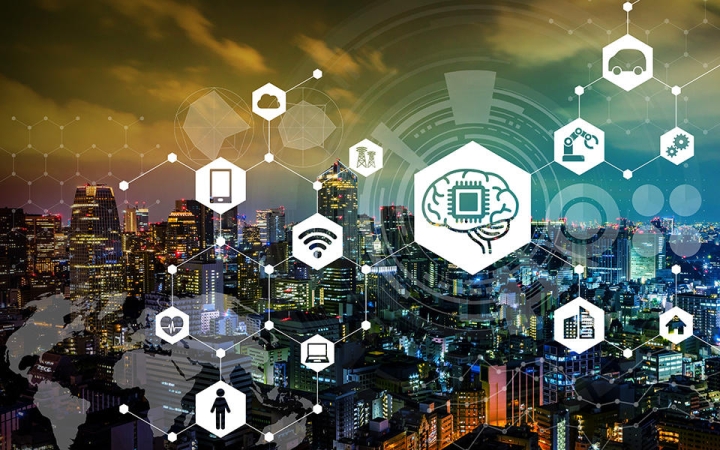March 30, 2021
Saab trials 3D-printed part on Gripen for battlefield repairs - Skies Mag
Saab successfully conducted a trial which marked the first time an exterior 3D-printed part has been flown on a Gripen.
January 21, 2020 | International, Big data and Artifical Intelligence

By: Charles Romine
Artificial Intelligence (AI) promises to grow the economy and improve our lives, but with these benefits, it also brings new risks that society is grappling with. How can we be sure this new technology is not just innovative and helpful, but also trustworthy, unbiased, and resilient in the face of attack? We sat down with NIST Information Technology Lab Director Chuck Romine to learn how measurement science can help provide answers.
One of the challenges with defining artificial intelligence is that if you put 10 people in a room, you get 11 different definitions. It's a moving target. We haven't converged yet on exactly what the definition is, but I think NIST can play an important role here. What we can't do, and what we never do, is go off in a room and think deep thoughts and say we have the definition. We engage the community.
That said, we're using a narrow working definition specifically for the satisfaction of the Executive Order on Maintaining American Leadership in Artificial Intelligence, which makes us responsible for providing guidance to the federal government on how it should engage in the standards arena for AI. We acknowledge that there are multiple definitions out there, but from our perspective, an AI system is one that exhibits reasoning and performs some sort of automated decision-making without the interference of a human.
AI systems will need to exhibit characteristics like resilience, security and privacy if they're going to be useful and people can adopt them without fear. That's what we mean by trustworthy. Our aim is to help ensure these desirable characteristics. We want systems that are capable of either combating cybersecurity attacks, or, perhaps more importantly, at least recognizing when they are being attacked. We need to protect people's privacy. If systems are going to operate in life-or-death type of environments, whether it's in medicine or transportation, people need to be able to trust AI will make the right decisions and not jeopardize their health or well-being.
Resilience is important. An artificial intelligence system needs to be able to fail gracefully. For example, let's say you train an artificial intelligence system to operate in a certain environment. Well, what if the system is taken out of its comfort zone, so to speak? One very real possibility is catastrophic failure. That's clearly not desirable, especially if you have the AI deployed in systems that operate critical infrastructure or our transportation systems. So, if the AI is outside of the boundaries of its nominal operating environment, can it fail in such a way that it doesn't cause a disaster, and can it recover from that in a way that allows it to continue to operate? These are the characteristics that we're looking for in a trustworthy artificial intelligence system.
Industry has a remarkable ability to innovate and to provide new capabilities that people don't even realize that they need or want. And they're doing that now in the AI consumer space. What they don't often do is to combine that push to market with deep thought about how to measure characteristics that are going to be important in the future. And we're talking about, again, privacy, security and resilience ... trustworthiness. Those things are critically important, but many companies that are developing and marketing new AI capabilities and products may not have taken those characteristics into consideration. Ultimately, I think there's a risk of a consumer backlash where people may start saying these things are too easy to compromise and they're betraying too much of my personal information, so get them out of my house.
What we can do to help, and the reason that we've prioritized trustworthy AI, is we can provide that foundational work that people in the consumer space need to manage those risks overall. And I think that the drumbeat for that will get increasingly louder as AI systems begin to be marketed for more than entertainment. Especially at the point when they start to operate critical infrastructure, we're going to need a little more assurance.
That's where NIST can come together with industry to think about those things, and we've already had some conversations with industry about what trustworthy AI means and how we can get there.
I'm often asked, how is it even possible to influence a trillion-dollar, multitrillion-dollar industry on a budget of $150 million? And the answer is, if we were sitting in our offices doing our own work independent of industry, we would never be able to. But that's not what we do. We can work in partnership with industry, and we do that routinely. And they trust us, they're thrilled when we show up, and they're eager to work with us.
I think some of this has been overhyped. At the same time, I think it's important to acknowledge that risks are there, and that they can be pretty high if they're not managed ahead of time. For the foreseeable future, however, these systems are going to be too fragile and too dependent on us to worry about them taking over. I think the biggest revolution is not AI taking over, but AI augmenting human intelligence.
We're seeing examples of that now, for instance, in the area of face recognition. The algorithms for face recognition have improved at an astonishing rate over the last seven years. We're now at the point where, under controlled circumstances, the best artificial intelligence algorithms perform on par with the best human face recognizers. A fascinating thing we learned recently, and published in a report, is that if you take two trained human face recognizers and put them together, the dual system doesn't perform appreciably better than either one of them alone. If you take two top-performing algorithms, the combination of the two doesn't really perform much better than either one of them alone. But if you put the best algorithm together with a trained recognizer, that system performs substantially better than either one of them alone. So, I think, human augmentation by AI is going to be the revolution.
I think one of the things that is going to be necessary for us is pulling out the desirable characteristics like usability, interoperability, resilience, security, privacy and all the things that will require a certain amount of care to build into the systems, and get innovators to start incorporating them. Guidance and standards can help to do that.
Last year, we published our plan for how the federal government should engage in the AI standards development process. I think there's general agreement that guidance will be needed for interoperability, security, reliability, robustness, these characteristics that we want AI systems to exhibit if they're going to be trusted.
https://www.nist.gov/blogs/taking-measure/trustworthy-ai-conversation-nists-chuck-romine

March 30, 2021
Saab successfully conducted a trial which marked the first time an exterior 3D-printed part has been flown on a Gripen.

December 16, 2019
The Army is looking for new technology that can be in the hands of Soldiers by 2023. So we're inviting companies to share their ideas for the chance to "pitch" us during Innovation Days in Austin and earn a new Army contract. To be considered, submit your concept through our online portal, which guides you through the required information in a Turbo Tax® style. You can find more information on what to include in this quick overview or via the announcement. You may not know all of the answers, and that's ok. The more technical details, visuals, and vision you can share to illustrate your technology, the better we'll be able to assess it against the Army's needs. The deadline to submit concepts for this event is 4:00pm ET on December 20, 2019. We can't wait to see what you've got! https://aal.army/innovationdays/

December 1, 2020
Andrew Eversden WASHINGTON — Experts expect President-elect Joe Biden's administration to build on the Trump administration's investments in emerging technologies, while adding to research and development budgets in the Defense Department and across the federal government. The incoming Biden administration signaled throughout the campaign that basic research and development funding would be a priority. Biden wrote in Foreign Affairs he would make research and development a “cornerstone” of his presidency and pointed to the United States having the “greatest research universities in the world.” “It's basic research that's the area where you get the breakthroughs, and you need long-term, sustained investments to build up a strong S&T base,” said Martijn Rasser, a senior fellow at the Center for a New American Security's technology and national security program. Biden's R&D investment is an expected change from the Trump administration's approach, which experts have noted is narrower in scope and focused on harnessing private sector innovation. “The reality is the U.S. private sector has eclipsed the government, which in some ways that can be good,” said Rep. Jim Langevin, D-R.I., chairman of the House Armed Services Committee's Subcommittee on Intelligence and Emerging Threats and Capabilities. “The private sector can move with greater agility than the government, but the private sector may not be focusing on developing those exquisite technologies that we need for the war fighter.” Experts told C4ISRNET they expect the Biden administration to invest more money in basic research areas and to reform immigration laws that slowed the innovation pipeline from abroad to the United States. “China is closing in. They are spending every year more and more on R&D. They will soon, if not already, be spending as much as we are, if not more on R&D,” Langevin said told C4ISRNET. “Congress has woken up to this problem.” Basic research Perhaps the most likely area the Biden administration is poised to change is basic research and development funding. According to annual reports from the Congressional Research Service, the Trump administration consistently proposed top-line cuts to federal research and development in yearly budget proposals. This included the fiscal 2021 budget proposal's $13.8 billion decrease in defense R&D over the fiscal 2020 funding enacted by Congress. While the Pentagon has often been spared from such cuts, the Trump administration has also suggested trimming the defense-related basic research budget line — money that is a “substantial source of federal funds for university R&D,” according to the Congressional Research Service. The White House's FY21 defense-related basic research budget line asked for a reduction of about 11 percent from FY20 enacted, or a $284.2 million decrease. Biden's campaign platform calls for a four-year investment of $300 billion in R&D for new technology such as 5G, artificial intelligence, advanced materials and electric cars. “A nation speaks to and identifies its priorities by where it puts its research dollars, where it puts its money,” Langevin said. “Basic research has to be more of a priority, and that's something I'm going to encourage the Biden administration to focus on.” Michèle Flournoy, thought to be a leading contender to become the next secretary of defense, has also written about the need to increase investment in emerging technologies to counter China. In Foreign Affairs in June, Flournoy wrote that “resilient battlefield networks, artificial intelligence to support faster decision-making, fleets of unmanned systems, and hypersonic and long-range precision missiles” will “ultimately determine military success.” “Continuing to underinvest in these emerging capabilities will ultimately have dire costs for U.S. deterrence,” she wrote. Congressional and think tank reports published during the Trump administration's tenure called for an increase in basic research funding. A report from the House Permanent Select Committee on Intelligence's strategic tech and advanced research subpanel, led by Rep. Jim Himes, D-Conn., recommended bumping up federal research and development funding from 0.7 percent to 1.1 percent of gross domestic product, or an increase of $146 billion to $230 billion. A report by the Council on Foreign Relations from 2019 applauded the Trump administration's requested increases in funding for the Defense Advanced Research Projects Agency, now funded at $3.46 billion, and the Defense Innovation Unit, for which the Trump administration requested $164 million. Laying the groundwork Initiatives started under the Trump administration did provide a groundwork on which the Biden administration can build. Under the Trump administration, DARPA kicked off a $1.5 billion microelectronics effort. In artificial intelligence, the administration launched the American AI Initiative. However, the Council on Foreign Relations criticized that effort because it had no funding and left agencies to prioritize artificial intelligence R&D spending without metrics, while also drawing funds from other research areas. The administration also made an $1.2 billion investment in quantum information science. “The Trump administration started bringing national attention and federal focus to many of these technologies,” said Lindsey Sheppard, a fellow at the Center for Strategic and International Studies. “I hope to see from the Biden administration perhaps a more cohesive guiding strategy for all of these pieces.” While the Trump administration has started many initiatives, the Council on Foreign Relations report also criticized the Trump administration's innovation strategy as an “incremental and limited approach,” writing that “action does not match the language officials use to describe the importance of AI to U.S. economic and national security.” While investment in future technology is important, defense budgets are expected to stay flat or decrease in the coming years. In her Foreign Affairs article, Flournoy acknowledge that the budgetary reality will require “tough tradeoffs.” Experts agree. “R&D programs are going to have to start being able to consistently, clearly articulate justifications for their budgets and the returns on investment,” Sheppard said. But the coronavirus pandemic has highlighted the need for increased investments in research and development, Himes and Langevin argued. Both lawmakers identified biothreats as something they fear for the future. Biological threats are one area that DARPA — an organization Langevin pointed to as a major federal R&D success story — has triumphantly address. Commercial partners from DARPA's 3-year-old pandemic prevention platform program announced they developed a COVID-19 therapeutic using new techniques. “There's absolutely going to be a rethink,” Himes told C4ISRNET in an interview. “Are we correctly allocating money between the possibility that there could be a pandemic that kills a million Americans, versus the possibility that we're going to have to fight the Russians in the Fulda Gap? I think there's going be a lot of thinking about that. And there should be thinking about that because our money should go to those areas where there's the highest probability of dead Americans.” Immigration innovation Another way to improve American innovation in critical future technologies is by allowing highly skilled foreigners to work in the United States. Biden has hinted at changes that will affect American innovation through the expected reversals of President Donald Trump's immigration policies, which limited high-skilled workers from legally working in the country. The Biden administration's platform states it wants to reform the H-1B visa process that the Trump administration restricted, much to the chagrin of American tech companies, which use the program to hire top talent from abroad. Think tanks have recommended reforming the current U.S. immigration policy to attract international students, entrepreneurs and high-skilled workers because of the innovative ideas they provide. For example, an analysis by Georgetown University's Center for Security and Technology found that 68 percent of the United States' top 50 artificial intelligence companies were co-founded by immigrants, most of whom came the U.S. as students. “A lot of the Trump administration's policies — we're shooting ourselves in the foot making it so much harder for people to come here,” said Rasser, who wrote a report for CNAS last year calling for H1-B caps to be increased. “Because of the fact that people want to come to the United States to live and work, that's one of our greatest competitive advantages. It's something I expect the Biden administration to reverse.” https://www.c4isrnet.com/smr/transition/2020/11/29/how-the-biden-administration-is-expected-to-approach-tech-research-and-development/